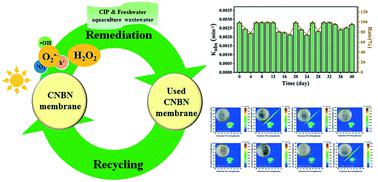当前位置:
X-MOL 学术
›
Environ. Sci.: Nano
›
论文详情
Our official English website, www.x-mol.net, welcomes your
feedback! (Note: you will need to create a separate account there.)
Photocatalytic degradation of ciprofloxacin in freshwater aquaculture wastewater by a CNBN membrane: mechanism, antibacterial activity, and cyclability
Environmental Science: Nano ( IF 5.8 ) Pub Date : 2022-07-08 , DOI: 10.1039/d2en00468b Zhenjun Xiao 1 , Yixun Zheng 1 , Ping Chen 1 , Haijin Liu 2 , Zheng Fang 1 , Junlong Zhang 3 , Zifeng Lin 1 , Yudan Zhang 1 , Jin Luo 1 , Weihong Zhang 1 , Wenying Lv 1 , Guoguang Liu 1
Environmental Science: Nano ( IF 5.8 ) Pub Date : 2022-07-08 , DOI: 10.1039/d2en00468b Zhenjun Xiao 1 , Yixun Zheng 1 , Ping Chen 1 , Haijin Liu 2 , Zheng Fang 1 , Junlong Zhang 3 , Zifeng Lin 1 , Yudan Zhang 1 , Jin Luo 1 , Weihong Zhang 1 , Wenying Lv 1 , Guoguang Liu 1
Affiliation

|
The increasing emergence of contaminants in freshwater aquaculture wastewater is of growing ecotoxicological concern. Herein, a carbon nitride modified boron nitride (CNBN) membrane was synthesized by moulding the nanosized CNBN into membrane shape, which was applied to remediate contaminated aquaculture wastewater sustainably. It was confirmed through characterization studies that the structure and properties of CNBN were retained after moulding to membrane shape. Under simulated sunlight, the CNBN membrane had effective degradation activity on ciprofloxacin (CIP) and other emerging contaminants in freshwater aquaculture wastewater. The degradation of CIP followed first-order kinetics, where O2˙−, ˙OH, and h+ played major roles during the degradation process. Compared with ultrapure water, the quantity of ˙OH in the freshwater aquaculture wastewater decreased significantly, attributed to the non-selective degradation properties of ˙OH. Coexisting substances, including HA, Mg2+, Ca2+, NO3−, NO2−, and Cl−, were observed to inhibit the photocatalytic activities of the CNBN membrane. The CIP transformation pathways mainly occurred via shedding of functional groups and ring-opening reactions. By simulating the long-term application of the CNBN membrane for the remediation of freshwater aquaculture wastewater, it was observed to maintain stable photocatalytic efficacy for the degradation of CIP for at least 40 days. In addition, the capacities of the CNBN membrane for the removal of antibiotic properties were elucidated. Ultimately, the excellent photocatalytic cyclability and prolonged performance of the CNBN membrane in freshwater aquaculture wastewater verified its potential application prospects.
中文翻译:

CNBN膜光催化降解淡水养殖废水中的环丙沙星:机理、抗菌活性和可循环性
淡水养殖废水中越来越多的污染物越来越引起生态毒理学关注。在此,通过将纳米CNBN成型为膜状,合成了氮化碳改性氮化硼(CNBN)膜,用于可持续修复受污染的水产养殖废水。通过表征研究证实,CNBN的结构和性能在成型为膜状后得以保留。在模拟阳光下,CNBN膜对淡水养殖废水中的环丙沙星(CIP)等新兴污染物具有有效的降解活性。CIP 的降解遵循一级动力学,其中 O 2 ˙ -、˙OH 和 h +在降解过程中发挥了重要作用。与超纯水相比,淡水养殖废水中的˙OH含量显着降低,这归因于˙OH的非选择性降解特性。观察到HA、Mg 2+、Ca 2+、NO 3 -、NO 2 -和Cl -等共存物质抑制CNBN膜的光催化活性。CIP转化途径主要发生在官能团脱落和开环反应。通过模拟 CNBN 膜在淡水养殖废水修复中的长期应用,观察到至少 40 天可保持稳定的光催化降解 CIP 效果。此外,还阐明了 CNBN 膜去除抗生素特性的能力。最终,CNBN膜在淡水养殖废水中优异的光催化循环性能和延长性能验证了其潜在的应用前景。
更新日期:2022-07-08
中文翻译:

CNBN膜光催化降解淡水养殖废水中的环丙沙星:机理、抗菌活性和可循环性
淡水养殖废水中越来越多的污染物越来越引起生态毒理学关注。在此,通过将纳米CNBN成型为膜状,合成了氮化碳改性氮化硼(CNBN)膜,用于可持续修复受污染的水产养殖废水。通过表征研究证实,CNBN的结构和性能在成型为膜状后得以保留。在模拟阳光下,CNBN膜对淡水养殖废水中的环丙沙星(CIP)等新兴污染物具有有效的降解活性。CIP 的降解遵循一级动力学,其中 O 2 ˙ -、˙OH 和 h +在降解过程中发挥了重要作用。与超纯水相比,淡水养殖废水中的˙OH含量显着降低,这归因于˙OH的非选择性降解特性。观察到HA、Mg 2+、Ca 2+、NO 3 -、NO 2 -和Cl -等共存物质抑制CNBN膜的光催化活性。CIP转化途径主要发生在官能团脱落和开环反应。通过模拟 CNBN 膜在淡水养殖废水修复中的长期应用,观察到至少 40 天可保持稳定的光催化降解 CIP 效果。此外,还阐明了 CNBN 膜去除抗生素特性的能力。最终,CNBN膜在淡水养殖废水中优异的光催化循环性能和延长性能验证了其潜在的应用前景。











































 京公网安备 11010802027423号
京公网安备 11010802027423号